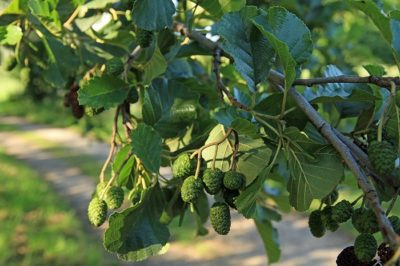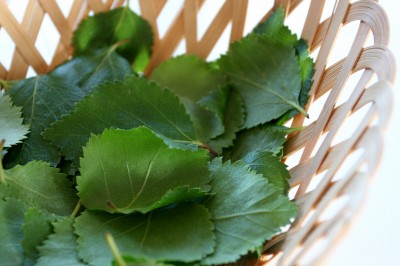
Alder tree. Image source: TreesPlantsFlowers blog
Growing your own groceries is one of the most important steps to developing an off-grid or self-reliant existence, but growing your own medicine should also be placed at the top of the “to-do” list.
Tending to medical needs is perhaps one of the most difficult aspects of preparedness. However, creating a pharmacy to harvest the healing bounty of Mother Nature is no more difficult than raising a typical garden.
Many trees that commonly grow in North America and parts of Europe possess medicinal benefits. During the fall and winter months most of the medicinal trees can offer roots, twigs and bark for the healing of a multitude of standard ailments. To ensure the longevity of the tree, never cut bark from the trunk of a living tree. It is also advisable to avoid ring barking or girdling the medicinal tree. The compete removal of an entire strip of bark from around the circumference of a trunk or branch can result in damage and ultimately the death, of wood tissues.
Let’s take an in-depth look at how to use trees for medicine, but first let’s examine 10 of the more popular medicinal trees:
- Alder – Astringent used as a wound wash and healing agent on deep wounds. Leaf and bark teas are used to treat tonsillitis, fever, as a douche, and for hemorrhoids.
- Apple – Tree bark is used to treat fevers and diarrhea. Stewed apples can be used as a laxative. Baked apples are great as a warm poultice for fevers and sore throat. Apple cider helps destroy intestinal flora and decrease bacteria flowing to the bowels.
- Ash – Twig tips and leaves turned into a tea help reduce rheumatism, jaundice and gout.
- Beech – Bark tea from this tree will help treat lung problems and was once used in tuberculosis treatments. It is also used to help cleanse the blood. Beech tea is not recommended for pregnant women. Leaf tea is used in poultices to treat frostbite and burns.
- Birch – Leaf tea helps heal sores in the mouth and helps heal bladder and kidney problems, and gout. Use bark in a bath to aid psoriasis, skin rashes and eczema. Birch sap contains betulinic acid, which is used to help reduce tumors and fight cancer.
- Cedar – Bark tea is used to treat fevers, rheumatism, the flu and chest colds.
- Elder – Bark tea is used to treat headaches, for congestion, and to lower fever by inducing perspiration.
- Elm – Bark salve and poultices are used to treat gunshot wounds, chilblain, and on the abdomen to draw out fever. Bark tea is very high in calcium and helps increase the healing of injured bones, heal sore throats, soothe urinary and bowel issues, and to thwart diarrhea.
- Hawthorne – Leaf tea is brewed as a “cardiac tonic” but extended use is known to cause a drop in blood pressure. It is recommended to use it for just two weeks and then take a week off before starting the treatment again.
- Maple – A leaf wound wash or poultice is used to relieve sore eyes and soreness of the breasts for nursing mothers and pregnant women. Bark tea is used to treat kidney infections, the common cold and bronchitis.
Bark as Medicine
The medicinal benefits from the bark are found in the greenish yellow or green or cambium layer just beneath the outer portion of the bark. Bark can be dried and saved for the future or put to immediate use.
The hidden secrets of making herbal medicines…right at your fingertips!
To dry the bark properly without damaging or over-drying the cambium layer, place the bark in a shaded area and do not overlap the pieces. To prepare the bark for use, simmer about two teaspoons of the matter with one cup of water for about 20 minutes in a non-aluminum pot – with the lid on. Strain the water off, allow to cool, then pour in a cup and drink.
One dose is approximately one-quarter of a cup. The bark medicine is presumed safe to drink up to four times a day for adults around 150 pounds; consume with a meal. Children and 75 pounds and smaller adults should reduce the bark tea ingested by half. Younger children who weigh less than 40 pounds should decrease the dosage by half yet again. The bark tea can be stored in a firmly sealed mason or other glass jar for up to a week.
Leaves as Medicine

Image source: theutopian.net
During the spring and summer months, the leaves are used for health aids. Steep approximately two teaspoons of either dried or fresh leaves per one cup of boiled water for about 20 minutes. Do not use an aluminum pot and keep the pot lid on during the process. The dosage amounts are the same as with the tea bark. A little bit of honey or lemon can be added to improve the taste.
Wound Washes and Poultices
If the leaf or bark tea will be used in the bath water to treat an irritation or as a wound wash, increase the amount of bark or leaves slightly and decrease the water just a bit as well. Simmering or steeping for a few more minutes is also advised. To make a tree leaf poultice, manually or in a blender, mix the tea into a mush and add more leaf or bark (especially elm bark) until the mixture reaches a dough-type consistency. Spread the mixture onto a clean cotton cloth and apply to the wound. Leave the poultice on for about an hour before discarding. This process can be repeated daily until the wound has healed.
A fomentation-style poultice made out of either bark tea or leaf tea involves soaking the significantly more liquid mixture onto a clean cotton cloth and then applying to the wound.
Salves
To make a bark tea or leaf tea salve, put the matter in a non-aluminum pot and cover it with olive oil – the cold-pressed virgin variety is reportedly the best option. Simmer for approximately 20 minutes in a lid-covered pot. Melt beeswax in a separate pot and allow to simmer for 20 minutes as well. Three tablespoons of beeswax for every cup of olive oil is the proper ratio. Stir the contents of the two pots together, allowing it to cool and harden before storing in a glass jar with a snug lid.
Tinctures
To make a bark tincture, use the roots, bark or buds from the tree. Chop the matter into small chunks and place inside a glass container. Cover the pieces with 80 proof or higher alcohol; vodka is commonly used. Cover the glass container with a tight-fitting lid and allow to sit for eight days, shaking occasionally each day. Then add one cup of water (spring water is recommended) and one teaspoon of vegetable glycerin. Strain the material, put it in a glass bottle, and store in a cool dark place for future use.
To make a leaf tincture, follow the same initial steps as with the bark tincture, but allow the mixture to sit until the leaves or tree blossoms show signs of wilting. Follow the same water, glycerin, straining and storage steps as the bark tincture. One dose of either tincture is about 10 drops taken up to three times per day. The dose is better taken with a big gulp of water.
What is your favorite medicinal tree? What tips would you add? Let us know in the comments section below.
Sign up for Off The Grid News’ weekly email and stay informed about the issues important to you
 Off The Grid News Better Ideas For Off The Grid Living
Off The Grid News Better Ideas For Off The Grid Living




